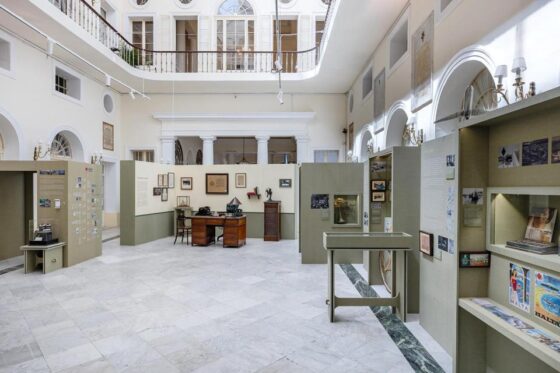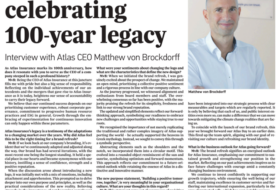
Centennial Chronicles: A celebration of Malta’s commercial legacy
Thi article originally appeared in the Times of Malta.
The exhibition setup at The Malta Chamber, which will be open to the public between April 18 and May 28.
A 100-year legacy is a momentous one. It embodies the intertwining narratives of countless lives traversing the corridors of time, the stories that speak volumes of human endeavour, the march of progress and myriad events. To commemorate this remarkable occasion, Atlas Insurance has chosen to put together an exhibition of commercial history in Malta rather than concentrate on its own journey alone, highlighting the fact that it is the commercial legacy of its clients which has made Atlas what it is today – and made the Atlas story.
The exhibition is currently running at The Malta Chamber in Valletta. Themed ‘Centennial Chronicles: Celebrating Malta’s Commercial Legacy’, the exhibition offers a unique and distinctive experience. As it pays tribute to the entrepreneurs and businesses which have left an indelible mark on Malta’s commercial landscape, the exhibition simultaneously honours the broader context of Malta’s rich cultural history, political dynamics, and economic development that are deeply intertwined with Atlas Insurance’s own narrative. There is also a section highlighting the Atlas story – the story of the individuals who have played pivotal roles in shaping the journey towards the making of Atlas Insurance, the precursor family businesses that merged and partnered over the years.

A rare example of a sermon written in the Maltese language. This extract from ‘Il Discorso del Santissimo Sagramento per li Naviganti’ captures the sailors’ vulnerability at sea and their relationship to faith. This is an important early documented example of Maltese in written form dating back to 1791 by Padre Fedele (1762c – 1824) who was a Capuchin friar from Valletta. On loan from the Archives of the Metropolitan Chapter, Malta.
The exhibition was curated by Justine Balzan Demajo, whilst archiving and research was carried out by Nikolai Debono. Open from Monday to Friday until May 28 between 8am and 4.30pm, there will be daily curatorial tours on a drop-in basis at lunchtime from April 22. Details of these and of the various events and evening tours are available on the Atlas website. Lectures by Liam Gauci, Dr Philip Farrugia Randon and Dr Mario Brincat will shed light on various aspects of commercial history, from corsairing to memories of Valletta in the mid-twentieth century to economic history between 1945-1959. Bookings for these as well as evening curatorial tours will also be available online through the Atlas website.
From its homage to our national and commercial heritage, the exhibition cleverly demonstrates how insurance business constitutes a dynamic mirror to the evolving patterns of society’s lifestyle and commerce, adapting to reflect the needs and risks of each period. From insuring bicycles during wartime when bicycle theft became a serious threat to insuring the interconnector cable today, the exhibition shows how insurance acts as an invisible shield supporting the changing risks emerging as society, commerce and the regulatory environment develops.

Malta introduced Value Added Tax (VAT) in 1995 as part of the EU accession process. This introduction was met with criticism, as in these satirical bank notes produced by the Opposition in the period.
The exhibition starts from a very interesting pre-20th century corner showing some very early local insurance records, ex-votos and contracts loaned to Atlas from some of the greatest collections on the island. The exhibition then showcases twenty-year periods of time culminating with EU accession which is also the time when Atlas came of age and was licensed by the MFSA as a local company and no longer an agent for a UK insurer.
Visitors will also be able to visit the reconstruction of a 1920s-1930s office of one of the Atlas predecessors with original artefacts from the period and from the Atlas collection. They can sit at the desk and peruse six vignettes on the tablet and get a feel for the issues of the day. From accounts of opposition to the colonial government’s banning of Maltese traders from boarding naval vessels to the rebutting of negative UK press reports about contracts with Maltese traders, they make very interesting reads.

Details from the reconstruction of a 1920s-1930s office, of one of the Atlas predecessors with original artefacts from the period. Photos: Lisa Attard/www.lisattard.com/@lisa_attard
Rooted in this rich history, ‘Centennial Chronicles’ presents a series of narratives that chronicle Malta’s transformative journey through exhibits retrieved from the archival records of Atlas Insurance’s past and present clients. However, the exhibition goes beyond historical recounting. A masterclass in storytelling that is executed with vision and sensitivity, the curatorial approach weaves the individual narratives of the exhibits into the broader socio-cultural fabric of their times.

‘Maravilla’ tea promotional figurine and cards, on loan from C. Camilleri & Sons.
While information boards serve as anchor points, providing context and reference points for a particular period, the heart of the exhibition’s narrative power lies within the exhibits themselves. Rather than artifacts and antiques, the exhibits are tangible echoes of daily life and commercial practices from the respective periods. Each piece, including objects from everyday life, carries with it stories of the past, offering a connection to the people who once used them, breathing life into the exhibition, and allowing visitors to grasp the tangible reality of the time.
Ambient factors, such as the overall space design and lighting, as well as music from the different eras are also employed to create a cohesive narrative journey that offers visitors a deeper understanding and a stronger emotional connection to the themes explored. This immersive experience is further enhanced by the strategic setting of the exhibition against the backdrop of the Chamber of Commerce’s Courtyard, symbolising the spirit of commerce, entrepreneurship and innovation that has long shaped and is still shaping our country’s development.

‘Cousis’ tobacco original advert and tin, on loan from Keith Camilleri and Julian Sammut.
For more information and bookings for curatorial tours and lectures, visit www.atlas.com.mt/chronicles


